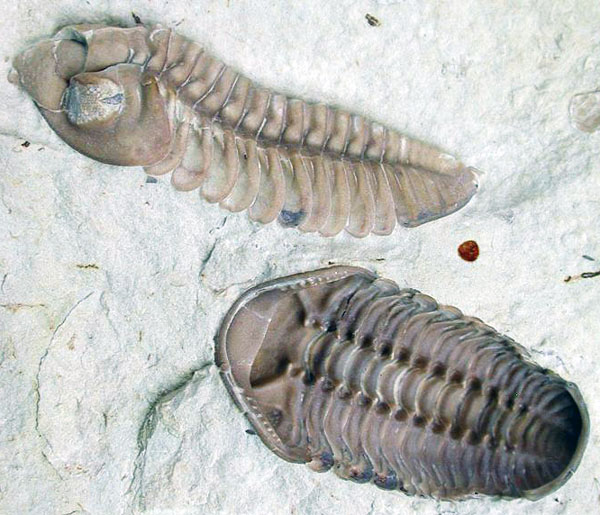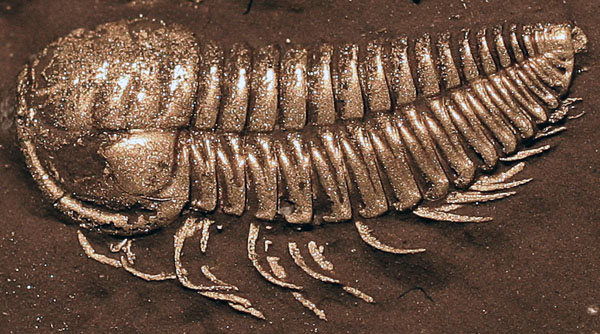Trilobites
Today, the evolution of the trilobite. The University of Houston's College of Engineering presents this series about the machines that make our civilization run, and the people whose ingenuity created them.
Trilobites Trilobites were ancient arthropods. They appeared in the Cambrian era, 540-million years ago. The nearest thing to a trilobite today is the horseshoe crab with a very similar exoskeleton. Trilobites lasted over 300-million years and finally died out not long before dinosaurs arose. Dinosaurs then lived another 160-million years. (By the way, the hardy cockroach, still with us today, once coexisted with trilobites.)
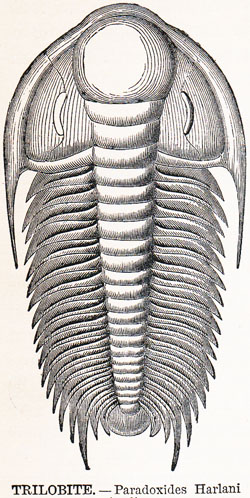
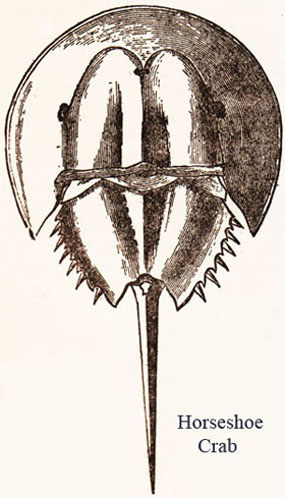
Trilobite-like creatures regularly turn up in sci-fi horror movies. They were ominous-looking life forms with many creepy legs under the wide segmented armor of their bodies. Like dinosaurs, they took many forms during their long stay on Earth. They ranged from less than a centimeter to two feet in length. And they were so plentiful that they fill the fossil record. One Edward Lhwyd found one in 1679 and reported to the Royal Society his discovery of "the skeleton of some Flat-Fish." A century later, naturalists realized these were not fish at all, but a distinct animal species. They called them trilobites because their bodies seemed to divide into three lobes.
Perhaps the greatest scientific payoff of our trilobite studies is how they've illuminated our knowledge of evolution -- their record is so complete. In 1933, a German Jewish scientist, Rudolf Kaufmann, published a remarkable trilobite study. He noted that their evolution was modest for long periods -- then it took large quick leaps. Major evolutionary change, it seems, was punctuated.
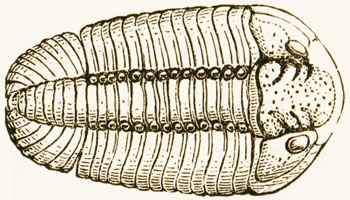 Kaufmann's work came out just as Hitler came to power. It was almost forgotten, as because both it and he were suppressed. He was killed by fascist guards eight years later. Richard Fortey's lyrical book Trilobite! Eyewitness to Evolutionrecounts Kaufmann's sad story. But Fortey also tells how Kaufmann's discovery resurfaced when Niles Eldridge and Steven Jay Gould gave it new life in their now-famous work on evolution as punctuated equilibrium. Behind it, of course, was our sturdy trilobite. And the trilobite's most remarkable evolutionary leap was the formation of a compound eye that was inorganic!
Kaufmann's work came out just as Hitler came to power. It was almost forgotten, as because both it and he were suppressed. He was killed by fascist guards eight years later. Richard Fortey's lyrical book Trilobite! Eyewitness to Evolutionrecounts Kaufmann's sad story. But Fortey also tells how Kaufmann's discovery resurfaced when Niles Eldridge and Steven Jay Gould gave it new life in their now-famous work on evolution as punctuated equilibrium. Behind it, of course, was our sturdy trilobite. And the trilobite's most remarkable evolutionary leap was the formation of a compound eye that was inorganic!
The many lenses of its eyes were tiny calcite crystals. Fortey talks about the evolution of sight in general, and how trilobites evolved this wholly unique form of sight. He quotes Shakespeare:
Full fathom five thy father lies;
Of his bones are coral made:
Those are pearl that were his eyes:
Well, calcite is exactly the material of pearl, but trilobites used its perfectly clear crystalline form to see.
So here was a strange creatures indeed -- a wondrous way-station in the process by which you and I and every living thing was created. Perhaps the trilobite offers yet another reminder -- that the brief three-and-a-half-million-year road from Lucy to you and me is only the beginning of a much longer story.
I'm John Lienhard at the University of Houston, where we're interested in the way inventive minds work.
R. Fortey, Trilobite! Eyewitness to Evolution. (New York: A. E. Knopf, 2000).
See also the Wikipedia entry on Trilobites.
My thanks to Dirk van Teurenhout, Houston Museum of Natural Science for his counsel. Dr. Teurenhout points out that the HMNS not only has examples of fossilized trilobites, it also exhibits living horseshoe crabs in its aquarium.
Images: Line drawings above from Dana's Textbook of Geology (1883 ed.) and the 1897 Encyclopaedia Britannica. Photos below courtesy of Wikipedia Commons.
